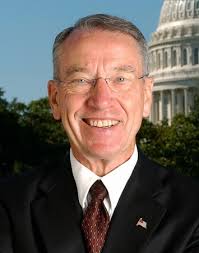U.S. Sen. Chuck Grassley (R-Iowa) sent another letter of inquiry into spending and accounting practices of Wounded Warrior Project (WWP), questioning the percentage the charity claims went to program expenses.
Grassley, chairman of the Committee on the Judiciary, yesterday sent a follow-up letter to WWP board chairman Anthony Odierno, giving the organization until June 1 to respond to a fresh set of questions seeking additional details on WWP’s programs, including in-kind donations.
In the four-page letter, the senator sought more information about a variety of areas of WWP’s finances and spending, including:
- Donated media and advertising of $80 million classified as program service;
- Joint allocation costs of $41 million;
- Some $37 million transferred to WWP’s Long-Term Support Trust and classified as program expenses.
- And, how much donor money was spent, as opposed to in-kind donations, for tickets to sporting events, which were the “vast majority” of the 90 percent of program services to veterans.
Grassley wrote that the organization’s claim that 80.6 percent of “its total expenditures went to provide services for veterans raises some serious questions.” WWP’s claim of almost 81 percent spent on program is based on its consolidated financial statements, not the federal Form 990. Using Form 990 data, 76.4 percent of expenses were spent on program, compared with 80.6 percent using the consolidated financial statements.
But one-third of program service spent on veterans – the $80.7 million – was free media and advertising. “This explains part of the numerical discrepancy between the two forms, but also partially illustrates how WWP arrives at its 80.6 percent figure. It includes free media as a program service to veterans. Excluding donated media would drop program service percentage to 66.6 percent.
“Senator Grassley isn’t rendering judgment at this point on whether the Wounded Warrior Project should use the figures reported on the 990 rather than the consolidated financial statements, just pointing out that the different forms can shed light on how WWP’s spending practices are potentially justified by the organization,” said Jill Gerber, a spokeswoman for the senator.
Another issue raised is how donated media is accounted for, an item that is handled differently on Form 990 than in consolidated financial statements. That’s one of several ways the two financial documents vary in classifying certain items.
WWP typically files its Form 990 in March but according to a spokeswoman, the board is scheduled to approve the 2015 form during a meeting in June. It’s unclear why the tax form is being filed later than in previous years.
In WWP’s Form 990 for the Fiscal Year 2014, functional expenses include almost $41 million in joint allocation costs that were classified as program service as well as educational and fundraising solicitations.
“It is not clear to what extent these solicitations provide any benefit to veterans or provide direct support to WWP’s mission,” Grassley wrote. “Further, most charity watchdog organizations do not count this type of spending as a program expense because it generally does not provide any benefit in support of a charity’s mission other than fundraising. As such, claiming this nearly $41 million as program services for veterans is questionable. And if no benefit is really derived for veterans, WWP’s program service percentage falls further below 80.6 percent.”
Grassley requested examples of joint educational and fundraising solicitations, along with a description of the benefit to veterans. It appears that approximately $150 million of the organization’s $242 million in program expenses “was not actually spent on veterans by WWP and a large portion of it was in-kind donations,” he wrote.
In a statement this afternoon, Wounded Warrior Project said: “We continue to maintain a productive dialogue with Senator Grassley’s office and look forward to answering his request for a more detailed explanation of how our programs and services provide essential support to wounded warriors.”
The treatment of joint cost allocation has become a flashpoint in the nonprofit sector, most recently when Charity Navigator in 2012 decided not to include joint costs in its ratings system. Joint cost allocation allows a portion of certain materials to be split between program and fundraising expenses under certain guidelines and criteria in accounting standards.
Joint cost allocation is among 20 standards enforced by the BBB Wise Giving Alliance. If a nonprofit allocates more than 50 percent of joint costs to program services, it would trigger more questions in its evaluation process.
Grassley previously had sent inquiries to the Jacksonville, Fla.-based charity after the organization dismissed its top two executives – CEO Steven Nardizzi and COO Al Giordano – amid media reports about “lavish” spending. The Charity Defense Council, which last year received a $150,000 grant from WWP, has come out criticizing the accuracy of the reports by The New York Times and CBS News.
An independent review of spending practices by outside audit and legal firms hired by the board confirmed the 80.6 percent figure spent on program and found no irregularities. The review did note that some policies, procedures and controls did not keep pace with the organization’s rapid growth in recent years, reporting revenue of $342 million in 2014 compared with $70 million just five years ago. Among other things, the senator also requested a copy of that review.











